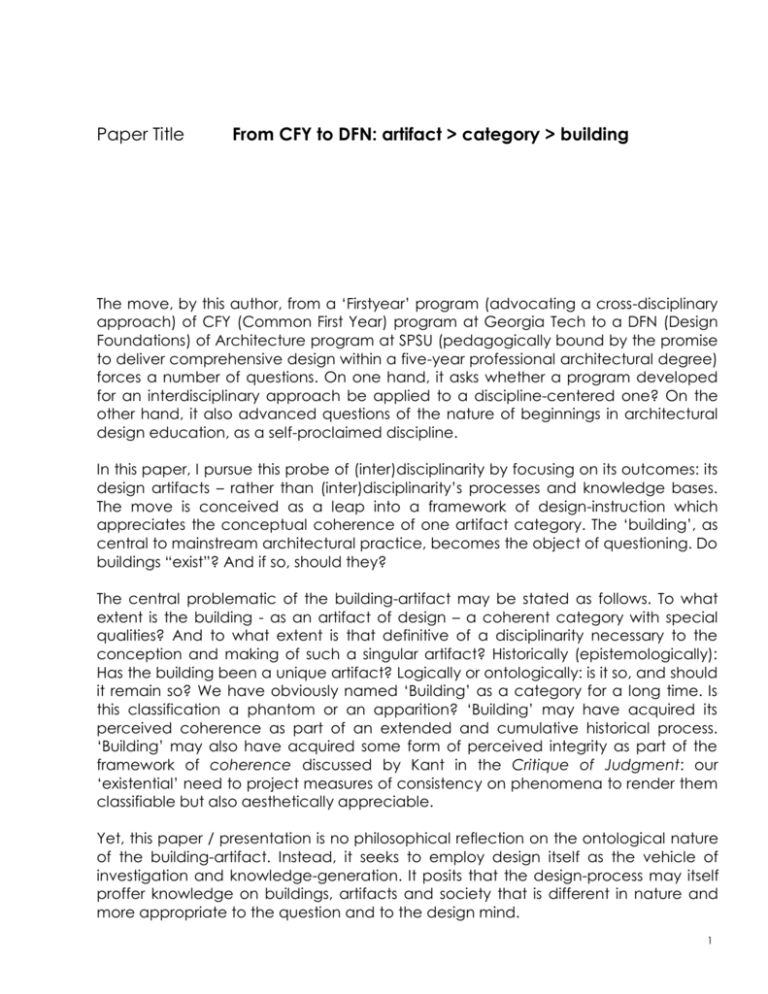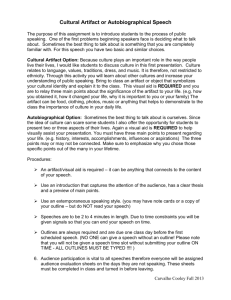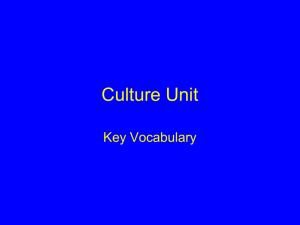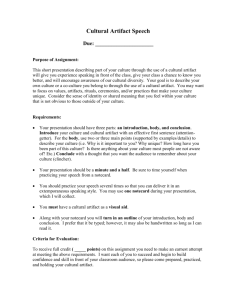42-155-1-PB
advertisement

Paper Title From CFY to DFN: artifact > category > building The move, by this author, from a ‘Firstyear’ program (advocating a cross-disciplinary approach) of CFY (Common First Year) program at Georgia Tech to a DFN (Design Foundations) of Architecture program at SPSU (pedagogically bound by the promise to deliver comprehensive design within a five-year professional architectural degree) forces a number of questions. On one hand, it asks whether a program developed for an interdisciplinary approach be applied to a discipline-centered one? On the other hand, it also advanced questions of the nature of beginnings in architectural design education, as a self-proclaimed discipline. In this paper, I pursue this probe of (inter)disciplinarity by focusing on its outcomes: its design artifacts – rather than (inter)disciplinarity’s processes and knowledge bases. The move is conceived as a leap into a framework of design-instruction which appreciates the conceptual coherence of one artifact category. The ‘building’, as central to mainstream architectural practice, becomes the object of questioning. Do buildings “exist”? And if so, should they? The central problematic of the building-artifact may be stated as follows. To what extent is the building - as an artifact of design – a coherent category with special qualities? And to what extent is that definitive of a disciplinarity necessary to the conception and making of such a singular artifact? Historically (epistemologically): Has the building been a unique artifact? Logically or ontologically: is it so, and should it remain so? We have obviously named ‘Building’ as a category for a long time. Is this classification a phantom or an apparition? ‘Building’ may have acquired its perceived coherence as part of an extended and cumulative historical process. ‘Building’ may also have acquired some form of perceived integrity as part of the framework of coherence discussed by Kant in the Critique of Judgment: our ‘existential’ need to project measures of consistency on phenomena to render them classifiable but also aesthetically appreciable. Yet, this paper / presentation is no philosophical reflection on the ontological nature of the building-artifact. Instead, it seeks to employ design itself as the vehicle of investigation and knowledge-generation. It posits that the design-process may itself proffer knowledge on buildings, artifacts and society that is different in nature and more appropriate to the question and to the design mind. 1 Figure 1 (left )an adhoc assembly from the Russian Revolution, 1917; (right) a reconstructed sectiontialaxon of the Mass Assembly Hall by N. Ladovski, Palace of Soviets Competition, 1931. 1 An early clue came by drawing on the design work of early Soviet architects, as analyzed by the author in ongoing doctoral research. The modern crowd was predominantly urban – amassed in the evolving industrial city from the late eighteenth through the early twentieth centuries. While the Industrial Revolution was born in rural settings, it soon relocated its manufactures within urban and suburban environs to make use of the large masses of cheap labor made available as a consequence of property alienation and rampant migration. Industrial capitalism moved to where it met the raw material of mass crowds. The confrontation was almost inevitable to unfold in the theater of the city as its native set, as attested by recurring revolutions and insurrections throughout the nineteenth century urban areas. Popular revolutions and mass parades were a common feature of the nineteenth century political scene – yet predominantly on the urban level (Ozouf 1988, von Geldern 1993, Schnapp, 2002). What marks the period of early modernism across Europe is the implication of architecture as both frame to, and medium for the negotiation of, mass social relations with the aim of evoking a rich variety of forms for social collectivity. Demand for mass events to be housed within building space (rather than urban space) significantly increased between the two world wars. A momentous political development, this was also an exceptional architectural problem as it sought to redefine the very nature of a building and its relation to the city. It was across this threshold – from the artifact of the city into the artifact of the building – that the crowd made its historic transition, and which the building now was called upon to mediate. 2 Figure 2 mapping gregarious diachronic rhythms for the assembly arena in ARU’s (Union of Architects and Planners), Palace of Soviets Competition entry, 1931. This also points to one fundamental property of the modern urban crowd of significant import: it is a mass perceived as well as conceived from an ‘alienating distance’ – from the outside. Customary tools of cultural representation were largely ‘external’ to the mostly illiterate crowd, if not altogether alien to it. The modern revolutionary crowd’s move from its indigenous urban setting into the building artifact was, historically and logically, attached to the crowd’s search for its innate identity and self-consciousness, the argument proceeded to understand the crowd design problem in terms of the crowd’s own generators of space, form and organization. In response, Soviet architects sought to deploy the building and its elements as means for discovering the crowd’s self-consciousness. Synchronic spaces, networks of co-visibility and co-action evoked within buildings, and the representational potential of building-shells (as backgrounds constructive of foregrounds) were employed to facilitate the generation of the crowd’s self-awareness and internal solidarity: its intersubjectivity. It is not that the urban fabric of the city lacked such ingredients, but that the ‘building’ consolidated or intensified their performance in its more controlled, more sensitive medium. The building was indeed an artifact with exceptional sensitivity towards orchestrating social exchange – the management of co-presence. It had a validity as a classification; a performative validity – or a real singularity to misquote Manuel Delanda. 3 Figure 3 gesture drawings, from CFY & DFN. Effort vs. shape: inward-focused exertion vs. external morphing 2 It is with this kernel of a conception of the building-artifact in mind that the development of the CFY exercises proceeded – although, I have to confess, far more sub-consciously than this narrative make it seem. The argument begins with a demonstration of how some of the design exercises and projects of the interdisciplinary CFY program evolved as they migrated into the disciplinary DFN. More than others, these CFY exercises are highlighted because, through their development, they served to bridge into the disciplinarity at question, and to fleshout the understanding of the ‘building’ posited above. As well, the discussion illustrates some new exercises and projects that were built on, or introduced alongside, such evolutions. The progression points to an increased interest in issues of building-program – broadly and creatively conceived. In particular: the development of the introductory exercise of Gesture Drawings into an exploration of the choreography of bodies in relation to each other as well as to surrounding objects. This was guided by Rudolph Laban’s choreography theory (and its later iterations in others’ work), as a distinction between effort and shape body exertions. Laban distinguishes between exertions through which the body simply expends effort on the one hand, and other exertions through which the body relates to other bodies or objects around it or to itself, on the other hand. The latter – “spatial movements” – constitute an integral part of a subtle, sub-conscious language which we employ to communicate and to generate inter-subjectivity. A specific kind of such traffic may be cast in terms of ‘action-signs’ (Williams 1995): culturally-codified moves with which we communicate moods, impressions and information to others. These are ephemeral acts with which we complement equally ephemeral verbal-signs. Some are codified into symbolic actions (e.g. the bow in prayer or in Tai-Chi). Yet action-signs are but a special case of a much larger pool of this gregarious spatial performance. In addition, actual physical contact as well as 4 Figure 4 DFN Fall06- ex4/ redefine-a-window_filter student: (Ruben Chitu,]: a redeployment of gesture drawings as design instruments; below: designed window-filter. establishing a concept of the body may also play an important role. But perhaps most pervasive are such uncodified rhythms of spatial movements with which we communicate affect. This minutiae of everyday gestures and postures, it constitutes the raw material from which a society’s system of communication is forged – and which is formalized in dance as an aesthetic form. Choreometric profiles (Kaeppler 1978) articulate such formalizations of everydaylife activities qualified by the form of flow and energy exerted, as well as the shapes and spatial planes and volumes employed. We perform such acts profusely, incessantly and quite subconsciously. While such moves may be performed in the course of socializing with others, they may also induced by the built environment. As the main mode of generic movement, walking may be stimulated in different speeds, to variant rhythms and accentuated by instances of looking and events of gathering. Different buildingarchitectures induce such movement rhythms and events differently. Walking is when bodies are in their most concerted proportions – whether in standing or walking, ascending or descending, our body parts and proportions remain coordinated in relation to each other inasmuch as everyday movement affords – and as induced by contact with building floors. Only when we sit or engage furniture or other building-elements do our bodily proportions assume more contorted – sometimes even fragmented – proportions and rhythms. Thus, while concerted generic-motion occurs in physical dialogue with the ground-plane, deformations occur in contact with other planes and elements. Furthermore, 5 Figure 5 DFN Create-a-Material Ex. (Fall06& Fall07); Inter-face/out(mis)-fit Ex. (Fall’07). movement – as induced by buildings - is more emphasized and visible in stairs and ramps. As architectural devices that manipulate speed and rhythm, such outgrowths of the ground-plane emphasize kinesthetic effects. Next, the paper maps the development of CFY’s Material Calisthenics Exercise onto two interrelated ones at DFN: Create-a-Material and inter-face / out(mis)-fit. The first asks students to develop material gymnastics into the generation of a ‘new material. This problematizes materiality not only in terms of internal bonds, density and resistances / tolerances to external forces but also as evocative of relations of empathy within the observer. As such, the exercise differentiates between material in the scientific sense and in the design sense. The latter, inter-face / out(mis)-fit, investigates the dimensions of this empathy and other possible sensations which the material may evoke. The exercise asks the students to develop the material they created into an artifact which it affords, mostly as a reinterpreted building element (e.g. a wall, or floor) or as a bodily-wrap (e.g. clothing) or a blend of both which collapses the distance between body and building. The exercise calls on students to then explore ways through which the body (singular or plural) adapts itself to this artifact and its material properties. What underlies this transposed response (the body responds to the artifact rather than the artifact becoming a prosthesis of the body) is a critique of humanist thought, which regards buildings as designed to wrap around the human body and as multiple measures of its stretch and activities. Humanist architecture addresses building-parts as extensions of the body’s grasp, its touch, its passage; building spaces are complex proportions of groups of bodies assembled or distributed. Instead, the exercise sought to furnish a post humanist framework. This sees built form, space and materials as more independent entities following their own logic – and to which the body adapts and responds, while also shaping and transforming them. A dialogue erupts between form and body that is vibrant and unpredictable. 6 Figure 6 DFN, PATH: events in sequence, Spring’07 (student: Lola) 3 It is along such a track that explorations at DFN developed. Building space was advanced as an artifact with which to manage co-presence, in innovative and creative ways – to discover rich, layered arrays of co-presence modes. To that end, the notion of the ‘event’ was introduced to students and the construction of event(s) - singular and plural – became a prime concern of the studio design process. An ‘event’ was taken to be an intense experiential moment with structural associations of the spatial, and the socio-political (the gaze, gender, race, …), and the psychological (the libidinal, …); it is an atomistic spatial experience with sociopolitical and psychological depths all at once. An event emerges when constructions of power (as a structural ingredient of social relations) find their spatial form or vice versa; political relations and space are mutually-defining. An event of power is a moment of significance when the ingredients of gaze, body and light converge to qualify each other generating a memorable moment of experience. What was stressed during the design process of constructing an event was the unpredictability of such a mix; one can only ‘discover’ the emergent spatial form as well as the kinds of social relations during the act of design itself. Beyond a single event, the process probes the configuration of multiple events. How do manifold events relate to each other: seamless, overlapping, mutually editing (synchronic), mutually exclusive (sequential, diachronic), …? What is the nature of the artifact(s) which emerge(s) from such assemblages of events? A sequence of events may structure a ‘path’ or alternatively a ‘warp’; a convergence of events may evoke an intersection, node or otherwise a collage. Yet what emerges, in turn, 7 Figure 7 DFN, ُ proj-1> gaze ¦ body ¦ light, Spring’07 (student: A. Dixon). Materializing co-presence; the warped screen magnifies body shadows at a location of intersecting vistas and light projections. from the higher order of such secondary assemblages? This poses as questions – rather than as givens - conventional conceptions of what constitutes a ‘building’, a ‘landscape’, ‘furniture’, …etc – to emancipate students’ minds from the confines of predetermined categories. One example of such a process is proj-1> gaze ¦ body ¦ light. This project tasked students to detect one event of power in the existing Architecture Building at SPSU, and transform that event in what amounts to a creative act of resistance. [Examples of students’ work will be shown in the presentation to demonstrate the varied and creative ways with which an ‘event’ may be enacted, and through which recastings of co-presence may be executed]. Next, the same students worked a project where an assemblage of events was explored in an open-ended way. The project problematized the conventional ‘module’ – or a rhythm of modules as an assemblage in a relatively straightforward design problem without pre-determining the nature of the ensuing artifact. This comes in contrast to an earlier iteration of the process in the Spring 2007, where students were assigned the tasks of creating a Threshold (as a single event), a Path (as a temporal sequence of two or more mutually-exclusive events) and an Intersection (as a more unpredictable convergence of multiple events). In other 8 Figure 8 DFN, proj-2> spatial assemblages, Spring’08 (student: B. Brouard). Mapping the panopticon gaze pattern on site (unequal or unreturned gazes; left) enabled the redefinition of programmatic activities in terms of ‘work’ (exposed) vs. play / bricolage (hidden). The scheme is structured around an assemblage of events of hidden play. words, the building-component in Fall 2007 was pre-set; the challenge was to articulate it. Figure7 includes an example form the Spring 2007 version. This past Spring 2008, the challenge was open-ended. It was through the exploration of multiple events, and as they are generated, that a description of the buildingcomponent emerges (see figure 8 for a student’s response to the challenge set in the project: Spatial Assemblages. 4 The outcome of such attempts is a working conception of the building which maintains its singularity (or some measure of exclusivity) while defining this in an open-ended way. It poses ‘building’ as an unpredictable assemblage of ‘events’ rather than as an entity pre-determined by any material, spatial or socio-economic confines. It underlines the ‘building’s’ exclusivity, while not precluding that its components may evolve into dynamic hybrids with other artifacts. Including this in a foundation studio, I hope, establishes a much-needed critical malleability of thought early in the beginning student’s education. 9 Bibliography Delanda, Manuel. “Anexact and Intense”. In NOX: Machining Architecture, Lars Spuybroek (main author and editor). Thames & Hudson 2004. Kaeppler, Adrienne L.. "Dance in Anthropological Perspective”, Annual Review of Anthropology, Vol. 7 (1978): pp. 31-49. Ozouf, Mona. Festivals and the French Revolution. Translated by Alan Sheridan. Cambridge, Mass: Harvard University Press, 1988. Williams, D. “Space, Intersubjectivity and the Conceptual Imperative: Three Ethnographic Cases”. In Human Action Signs In Cultural Context: The Visible and the Invisible in Movement and Dance, edited by Farnell, Brenda. Metuchen, N.J.: Scarecrow Press, 1995. Schnapp, Jeffrey T.. “The Mass Panorama”. MODERNISM / modernity, 9(2) (2002): pp. 243–281. Von Geldern, James. Bolshevik festivals, 1917-1920, Berkeley CA: University of California Press, c1993. Ziada, Hazem. “Can architectural space forge a new social collective? Mapping Co-presence in the Palace of Soviets Competition Entries”, Proceedings of the Fifth Space Syntax Symposium. Delft (The Netherlands), 2005. Ziada, Hazem. “Kinesthetic Foundations of Spatial Concepts and Configurations”, Proceedings of the Sixth Space Syntax Symposium., Istanbul, 2007. 10






